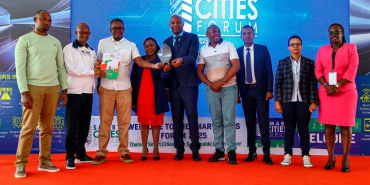Architects in Nairobi Say Colonial-Era Rules Block Innovation and Growth

A Kenyan design firm, LondonConsult, is challenging conventional architectural norms with its "Little Orbit" nursery school concept, which has garnered international recognition at the 2025 Kaira Looro Design Awards.
This accolade, which typically favours submissions from international architects, marks a significant validation for local innovation in a field often met with scepticism. The "Little Orbit" project distinguishes itself by treating childhood space with solemnity and reverence, departing from the traditional reliance on bright colours and playful motifs. Instead, the design creates a contemplative environment inspired by sacred spaces, positioning the nursery as a place of dignity and introspection. According to Adrian Madoya, the recognition was unexpected.
"We knew we had submitted something grounded in meaning, but were shocked when we got a special mention because every Kenyan project recognised at the award before ours had been authored by international architects," Madoya told DN2 Property.
The project's success has illuminated the systemic challenges hindering young architectural firms in Kenya. Madoya notes that despite demonstrating feasibility, innovative projects are often dismissed as impractical or overly idealistic.
“Our work has often been met with scepticism. We’ve never broken ground on any of our disruptive design commissions. In Kenya, we’re told to scale down, make ideas more realistic,” he said.
Robert Omondi, a built environment professional, asserts that outdated regulations, such as CAP 525, perpetuate colonial-era gatekeeping within the profession, stifling creativity and innovation. “These laws follow the structure of the colonial era when there was a lot of gatekeeping,” Omondi explained. “They are not aligned with current realities, and little has been done to make amendments over the years.”
The rigid regulatory environment impacts the adoption of emerging materials and technologies. Innovations like fibreglass are routinely rejected during the approval process, not due to inherent flaws but because they fall outside the purview of what regulatory boards deem acceptable. This paradox results in bold designs being celebrated internationally while remaining unbuildable in Kenya.
"The same progressive projects that do not break ground here because contractors don’t know where to start are recognised abroad," Omondi added.
Contractors, wary of the risks associated with unconventional designs, are often reluctant to collaborate with young professionals. Clients, too, frequently opt for familiar approaches, hesitant to invest in concepts that may encounter resistance during implementation.
“Clients will always take the safe approach,” Omondi said. “They want to be sure that a design can be implemented. If not, the architect will bear the costs. No young architect has the capacity to indemnify a client, and the older architects who have this capacity will not agree to offer support.”
This creates a professional landscape where young architects are relegated to small-scale or risk-averse projects, irrespective of their talent or vision, which limits their professional growth and deprives the country of architectural innovation.
The challenges are even more acute for women in the profession. Faith Nyambura, a designer with nearly a decade of experience, recounts the difficulties she faced during her pregnancy while working for a firm that undervalued her contributions.
“I felt like I was sacrificing my well-being and that of my unborn child for a job that wasn’t rewarding me, financially or emotionally,” she said.
Her decision to establish her own practice proved transformative, significantly increasing her earnings and allowing her to regain control over her career trajectory. Nyambura acknowledges that systemic gender bias continues to impede women’s advancement in the built environment. This bias often manifests in client interactions, where age and gender are used to undermine professional authority.
“I’ve had countless clients who, maybe because they have watched something online, believe they know as much about design as a professional who has gone to school and has hands-on experience,” she explained.
While collaboration with informed clients can yield positive outcomes, Nyambura warns that the dynamic shifts when clients disregard professional expertise.
Financial pressures are exacerbated by a broader undervaluation of design work. Architects frequently face fee reductions that undermine the viability of their practices, despite their central role in the construction process.
“It’s disheartening to put your heart and soul into a project only to see your compensation slashed to make the bottom line work,” Nyambura said.
The stories of Madoya, Omondi, and Nyambura depict an architectural profession in Kenya where innovation is suppressed, regulation is outdated, and young talent is systematically undervalued.








Add new comment